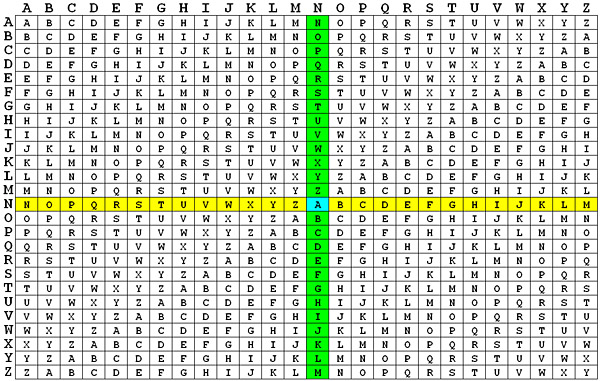

It is somewhat like a variable Caesar cipher, but the N changed with every letter. Since P is on column I, the corresponding plaintext letter is I. A 16 th century French diplomat, Blaise de Vigenere, created a very simple cipher that is moderately difficult for any unintended parties to decipher. This letter corresponds to the keyword letter H and row H is used to find P.

It was not broken until 1863 although these days it is highly insecure and is now only useful as an interesting programming exercise. Consider the fifth letter P in the ciphertext. The Vigenère Cipher was invented in 1553 by the Italian Giovan Battista Bellaso but is now erroniously named after the Frenchman Blaise de Vigenère. Then, the row of H is used to find the corresponding letter T and the column that contains T provides the plaintext letter M (see the above figures). Here is the calculator, which transforms entered text (encrypt or decrypt) using Vigenere cipher. For example, to decrypt the first letter T in the ciphertext, we find the corresponding letter H in the keyword. To decrypt, pick a letter in the ciphertext and its corresponding letter in the keyword, use the keyword letter to find the corresponding row, and the letter heading of the column that contains the ciphertext letter is the needed plaintext letter. The following has the plaintext, repeated keyword and ciphertext aligned together. Repeating this process until all plaintext letters are processed, the ciphertext is TWWNPZOA ASWNUHZBNWWGS NBVCSLYPMM. Similarly, since the letter N in MICHIGAN corresponds to the letter N in the keyword, the entry at the intersection of row N and column N is A which is the encrypted letter in the ciphertext This means that the row of H and the column of M are used, and the entry T at the intersection is the encrypted result. For example, the first letter in the plaintext is M and its corresponding keyword letter is H. To encrypt, pick a letter in the plaintext and its corresponding letter in the keyword, use the keyword letter and the plaintext letter as the row index and column index, respectively, and the entry at the row-column intersection is the letter in the ciphertext. As a result, the above plaintext and keyword become the following: MICHI GANTE CHNOL OGICA LUNIV ERSIT Y We follow the tradition by removing all spaces and punctuation, converting all letters to upper case, and dividing the result into 5-letter blocks. This was created to help decrypt the Kryptos sculpture. One creates the alphabet, the second is the encoding passphrase. Keyed Vigenere: This modified cipher uses an alphabet that is out of order. With our encoder you can both encode and decode each text with the Vigenre. A pretty strong cipher for beginners, and one that can be done on paper easily. Then, the keyword must be repeated as follows: MICHIGAN TECHNOLOGICAL UNIVERSITY The Vigenre cipher is one of the classic polyalphabetic substitution ciphers.
#Vigenere cipher decryption tool manual#
For example, suppose the plaintext is MICHIGAN TECHNOLOGICAL UNIVERSITY (used this example to accredit them for teaching me, used this skill alot for privacy) and the keyword is HOUGHTON. Saint-Cyr slide is a rule-shaped instrument, a tool that simplifies manual encryption and decryption of a message encrypted with Vigenere. In addition to the plaintext, the Vigenère cipher also requires a keyword, which is repeated so that the total length is equal to that of the plaintext.


 0 kommentar(er)
0 kommentar(er)
